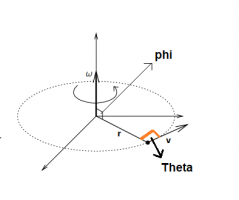topsquark
Senior Member
- Joined
- Aug 27, 2012
- Messages
- 2,363
In terms of the problem you were given
[imath]\dot{r} = \dot{R} R^T r[/imath]
To simplify things let's take motion in the xy plane so we have
[imath]R = \left ( \begin{matrix} cos( \theta ) & - sin( \theta ) & 0 \\ sin( \theta ) & cos( \theta ) & 0 \\ 0 & 0 & 1 \end{matrix} \right )[/imath]
And we get
[imath]\dot{R} R^T = \left ( \begin{matrix} 0 & - \dot{ \theta } & 0 \\ \dot{ \theta } & 0 & 0 \\ 0 & 0 & 0 \end{matrix} \right )[/imath]
So
[imath]\dot{r} = \left ( \begin{matrix} 0 & - \dot{ \theta } & 0 \\ \dot{ \theta } & 0 & 0 \\ 0 & 0 & 0 \end{matrix} \right ) r = \left ( \begin{matrix} 0 & - \dot{ \theta } & 0 \\ \dot{ \theta } & 0 & 0 \\ 0 & 0 & 0 \end{matrix} \right ) \left ( \begin{matrix} x \\ y \\ 0 \end{matrix} \right ) = \left ( \begin{matrix} 0 & -y & 0 \\ x & 0 & 0 \\ 0 & 0 & 0 \end{matrix} \right ) \dot{ \theta }[/imath]
Notice that [imath]\omega[/imath] here will be in the z direction, so notice that
[imath]r \times \omega = \left ( \begin{matrix} x \\ y \\ 0 \end{matrix} \right ) \times \left ( \begin{matrix} 0 \\ 0 \\ \dot{ \theta } \end{matrix} \right ) = \left ( \begin{matrix} 0 & -y & 0 \\ x & 0 & 0 \\ 0 & 0 & 0 \end{matrix} \right ) \dot{ \theta } = \dot{R} R^T r = \dot{r}[/imath]
or [imath]v = r \times \omega[/imath].
I don't know why the author didn't finish the job properly. All he did was draw a parallel to the cross product and say "Here's an example and voila!" It was all there but for some reason he simply didn't pick the right example.
-Dan
[imath]\dot{r} = \dot{R} R^T r[/imath]
To simplify things let's take motion in the xy plane so we have
[imath]R = \left ( \begin{matrix} cos( \theta ) & - sin( \theta ) & 0 \\ sin( \theta ) & cos( \theta ) & 0 \\ 0 & 0 & 1 \end{matrix} \right )[/imath]
And we get
[imath]\dot{R} R^T = \left ( \begin{matrix} 0 & - \dot{ \theta } & 0 \\ \dot{ \theta } & 0 & 0 \\ 0 & 0 & 0 \end{matrix} \right )[/imath]
So
[imath]\dot{r} = \left ( \begin{matrix} 0 & - \dot{ \theta } & 0 \\ \dot{ \theta } & 0 & 0 \\ 0 & 0 & 0 \end{matrix} \right ) r = \left ( \begin{matrix} 0 & - \dot{ \theta } & 0 \\ \dot{ \theta } & 0 & 0 \\ 0 & 0 & 0 \end{matrix} \right ) \left ( \begin{matrix} x \\ y \\ 0 \end{matrix} \right ) = \left ( \begin{matrix} 0 & -y & 0 \\ x & 0 & 0 \\ 0 & 0 & 0 \end{matrix} \right ) \dot{ \theta }[/imath]
Notice that [imath]\omega[/imath] here will be in the z direction, so notice that
[imath]r \times \omega = \left ( \begin{matrix} x \\ y \\ 0 \end{matrix} \right ) \times \left ( \begin{matrix} 0 \\ 0 \\ \dot{ \theta } \end{matrix} \right ) = \left ( \begin{matrix} 0 & -y & 0 \\ x & 0 & 0 \\ 0 & 0 & 0 \end{matrix} \right ) \dot{ \theta } = \dot{R} R^T r = \dot{r}[/imath]
or [imath]v = r \times \omega[/imath].
I don't know why the author didn't finish the job properly. All he did was draw a parallel to the cross product and say "Here's an example and voila!" It was all there but for some reason he simply didn't pick the right example.
-Dan

